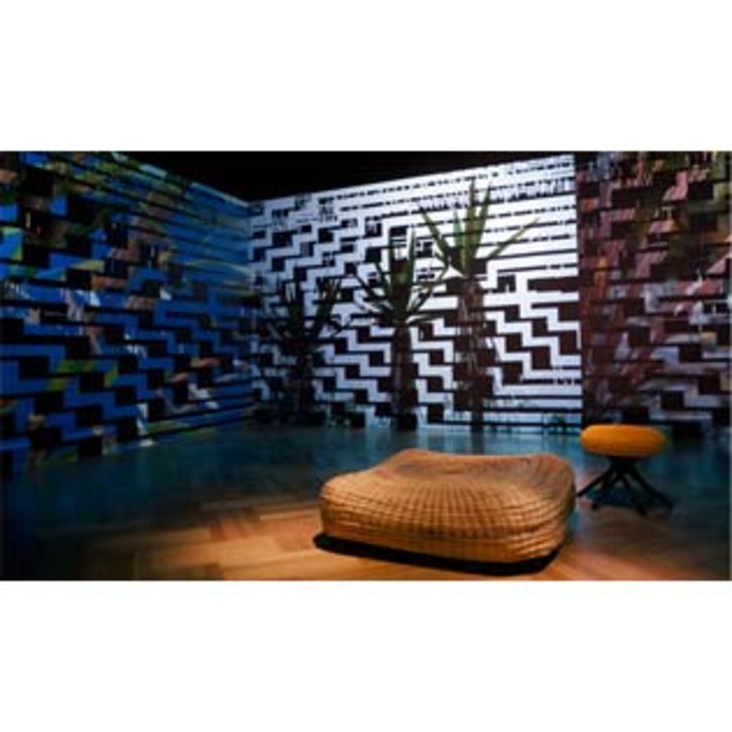Bruno Mathsson: Architect and Designer was the first exhibition in the United States to examine the work of this leading figure of Swedish modernism. Mathsson (1907–88) was a key international figure in 20th-century Swedish furniture and architectural design whose reputation and appeal continues to grow. This exhibition of approximately 150 examples of furniture, architectural drawings, photographs, and models was curated by Hedvig Hedqvist, the renowned Swedish art critic and design historian, and Karin Åberg Waern, curator at the Swedish Museum of Architecture in Stockholm. It was organized by The Bruno Mathsson Foundation, a nonprofit organization in Värnamo, Sweden, dedicated to preserving Mathsson’s legacy and supporting progressive design in Sweden in collaboration with The Swedish Museum of Architecture. The exhibition was circulated by the Swedish Institute in Stockholm.
Bruno Mathsson was born in Värnamo, Sweden. His father, Karl, whose furniture business would later manufacture many of Bruno’s designs, was a fourth-generation master joiner and gave his son a thorough knowledge of wood technology. From the beginning, Bruno was fascinated by the possibilities of developing the form and function of furniture using new wood technology. In the 1920s and 1930s he became deeply involved in studying and developing the functional possibilities of wood.
In 1931 Mathsson developed his first chair, the Grasshopper, for Värnamo Hospital to place in a reception area. (It was said that people found it so ugly it was quickly relegated to the attic.) But this innovative chair, with its woven, webbed seat stretched across a frame whose arm rest and legs were made of one arched wooden piece sculpted into an interpretation of a grasshopper’s legs, was his first expression of what furniture could and should be. He stripped away traditional upholstery, making the hemp webbing both functional and aesthetically pleasing, and began to develop the ultimate seating, which should, he believed, have the ability to separate into a lounge chair, an easy chair, and a work chair. He thought that individual furniture designs should interact with the room in which they were placed and with the architecture. He also discarded traditional ideas on the height of chairs and tables and created slender furniture forms and seating adapted to lower horizontal surfaces. Function and comfort were his primary objectives, and the mechanics of seating occupied his mind. Inspired by Le Corbusier, he experimented with the physiology of the seating curves adjusted according to the body, which in turn resulted in prototypes for the work, easy, and lounge chairs. His furniture is undoubtedly influenced by the bentwood designs of Alvar Aalto, but Mathsson’s commitment to bentwood and his range and virtuosity of the material exceeded all of his contemporaries, including Marcel Breuer, among others. Mathsson possessed an uncanny feeling for the material qualities of bentwood. His furniture designs are unique in their sensuously undulating lines and the elegant, organic way in which their contours echo the human form.
Mathsson’s international reputation was launched with the bentwood furniture he exhibited in the Swedish pavilion at the 1937 World Exposition in Paris. Edgar Kaufmann Jr. saw the furniture and recommended that the Eva Chair, then called the Work Chair, be purchased for the public rooms at the new Museum of Modern Art building in New York City, designed by Philip Goodwin and Edward Durrell Stone and completed in 1939. That same year, Mathsson furniture was shown at the Swedish pavilion at the New York World’s Fair, which provided further impetus for his extensive popularity and influence in the United States. During the 1940s Artek Pasco distributed the furniture, which became a commercial success, appearing in numerous domestic and public buildings designed by leading modern architects across the country. In 1949 Baldwin Kingrey, the largest retailer of modern furniture in the Midwest, gave Mathsson a one-man show in its Chicago store that received extensive publicity.
Mathsson’s popularity dwindled somewhat during the 1950s when, despite requests by many distributors of modern furniture (such as Knoll Associates) to manufacture and distribute his designs, he refused to relinquish control of them. Nor would he succumb to the demands of the marketplace by altering the specifications of his bentwood designs to enable larger orders. In the early 1950s he was still doing his own marketing and trying to maintain production according to his original specifications and distribute independently. Increasingly, his attention turned to architecture.
In the 1960s, Dux Industries, the Swedish furniture company, began manufacturing and distributing Mathsson bentwood furniture. Mathsson began working with tubular steel. His most audacious design from this period is the super ellipse table created in collaboration with Piet Hein, the Danish mathematician. The elegant table rested on span legs that could easily be removed with a tension mechanism. The span leg gave the impression of the elliptical form hovering in space. Mathsson continued to actively explore design possibilities into the 1980s, and he once again became interested in the office environment and the ergonomics of seating. He soon began designing for the electronic age, including computer tables and work stations. Today Mathsson furniture is manufactured by Bruno Mathsson International and by Dux Industries.
Following a visit to the famous Stockholm Exhibition in 1930, Mathsson became intrigued by the possibilities of modernism in design and architecture. Although the primary focus of his long and prodigious career was designing furniture, he aspired to be an architect. Self-taught, he often approached architecture in the same way he did furniture, experimenting with the inherent properties of different materials, particularly glass, and conceiving of architecture as a craft. He insisted that his designs respond to the basic needs of a modern lifestyle. His architectural interests were broadened when he visited the United States during 1948–49 and toured major urban centers across the country. Through Edgar Kaufmann Jr., he met many leading figures within modern design circles in this country and discovered new building methods and approaches to modern design that he adapted to his unique conception of architecture. Always wedded to the essential connection between man and nature, he developed a simple floor plan for the modern house, one that utilized large spans of glass. His primary goal was to enhance the connection between interior and exterior space, bringing the natural landscape as much as possible into the modern living or work space.
While working primarily as an architect of glass houses, Mathsson also developed patents for floor heating and for two- or three-paned windows, inspired by the American architect George Keck. Mathsson’s most accomplished house design, in 1955, employed passive solar heat for the Danderyd house. Perhaps his most effective single-family house is Kungsör (1954), located outside Stockholm, a combination residence and showroom that embodies the connections between interior and exterior space, which were always the leitmotif of Mathsson’s designs. The house and garden possess an intimacy that is obtained through an unusual triangular plan.
Mathsson designed Frösakull, one of the most daring examples of his glass houses, in 1960. The floor plan groups the rooms around two sides of a sun garden, with bedrooms along the northern side and a living room along the eastern side. The living room has glass walls on two sides, and a third side, facing the sun garden, can be opened. The walls dissolve the boundary between inside and outside. Sliding doors constructed from glass fiber reinforced with corrugated plastic make it possible to change the living room layout according to need, while the transparent plastic ceiling allows light to filter through a specially designed inner roof of wooden slats. The building, together with its furnishings, reflects Mathsson’s understanding of proportion and his commitment to exploiting the inherent properties of modern materials. This building—as with all Mathsson’s buildings at their best—has an extremely light and graceful construction. His most accomplished floor plans are simple and logical, incorporating a flexibility and orientation according to the points on the compass. The choice of materials is functional and experimental and emphasizes the dissolution of interior and exterior, while the use of an exterior “room” for healthier living, in the form of sun gardens, is a recurring theme.
Organized chronologically to effectively convey the ideas that Mathsson invested in the creation of his bentwood furniture designs, the exhibition traced the designer’s career from the end of the 1920s to the end of the 1980s. It featured more than 50 examples of the three furniture forms—lounge chair, easy chair, and work chair—and included a selection of dining, side, and work tables and desks that Mathsson designed, always catering to what he considered the specific needs of modern living. Swedish designers Anna von Schewen and Björn Dahlström planned the installation and recreated a room from Frösakull with furniture that visitors can sit in, to actually experience the pleasure of relaxing in a Mathsson chair in a Mathsson-designed room. Architectural drawings on loan to the exhibition from the Mathsson archives in Värnamo conveyed Mathsson’s approach to the domestic floor plan and the connection between nature and the modern interior. A digital slide show of color and black-and-white photographs was projected on the gallery walls, illustrating Mathsson’s exhibition interiors and the domestic and public buildings he designed from the 1930s through the 1970s.
Organized by The Bruno Mathsson Foundation, a nonprofit organization in Värnamo, Sweden, and curated by Hedvig Hedqvist, renowned Swedish art critic and design historian, and Karin Åberg Waern, curator at the Swedish Museum of Architecture in Stockholm.











